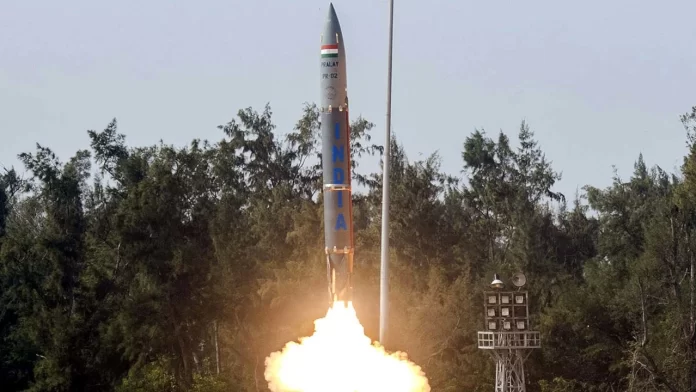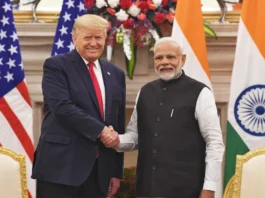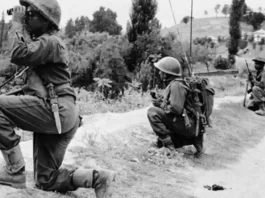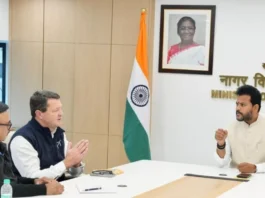It is believed that the recent test-firing of the Pralay surface-to-surface ballistic missile and its inclusion on the Defense Acquisition Council’s (DAC) final list mark the beginning of the development of an Integrated Rocket Force (IRF). The force could demonstrate India’s ability to wage non-contact warfare and could help establish an effective deterrent via denial against China and Pakistan along the Line of Actual Control (LAC) and Line of Control (LOC), respectively.
India faces multiple challenges along the 3,400-kilometer LAC and LOC. One among them is to develop options for deterrence with stand-off weapons and minimum use of conventional forces and keep the inevitable fight localised.
The introduction of the concept of IRF is already late in India. It was first referred to in late 2021. As the Russia-Ukraine conflict continues, the Indian Armed Forces are coming to understand that the future of warfare will depend on the efficient application of non-contact warfare principles in the planning of any military campaign. In September 2021, the late General Bipin Rawat stated that India should deploy a missile force. According to a report from 2022, the Indian Armed Forces are conceptualising and drafting a doctrine for the military theatre commands. The cyber, space and missile commands would be the first tri-services organisation and pave the way for the eventual formation of joint war commands.
A joint command is a long way to go, as inter-services rivalry is a known factor. But let’s see the usefulness of such a force. The assertion that there is a possibility of non-nuclear conflict between nuclear-armed competitors to conduct warfare has been bolstered due to the results of attacks in the Uri, Balakot, and Kailash range. India can conduct war against its adversaries with missiles in a deeper strike against military targets that support the frontline troops. Even though it can help with precision, faster response, and stealth, it can also bring a similar response from the adversary. It is impossible to understand the enemy’s reaction to sending aircraft and missiles into deeper airspace. India should be ready for such risks.
Compared to missiles and manned aircraft, loitering drones like the Shahed-136 are much less expensive for missions with limited ranges. Some Indian armed forces personnel live in the dark ages of unmanned aerial vehicle (UAV) technology when UAVs were mostly used for surveillance. Even in 2023, one can find such a retrograde mentality in the open literature among military personnel. Unlike prestigious think tanks worldwide, most Indian policy research and think tanks employ exclusively copy-and-paste academics whose papers contain over 95 per cent citations and no originality and hence no guidance to armed forces in most aspects. Most service and ex-service personnel are known to write reports tailored to please their respective forces rather than objectively.
IRF concept and Pralay Missile
Pralay is a quasi-ballistic, surface-to-surface missile constructed using components of previously tested Defence Research and Development (DRDO) built missiles, such as the exoatmospheric interceptor missile PDV (Prithvi Defence Vehicle) and the Prahaar tactical missile. The composite fuel was used in the Indian Navy’s underwater Sagarika missile family. The Pralay missile is comparable to the Chinese Dongfeng 12, the Russian 9k 720 Iskander missile, and the Precision Strike Missile (PrSM) of the United States Army. Pralay has an attack range of 150 to 500 kilometres, and its recent successful test launches and introduction of 120 missiles are expected to constitute the foundation of an Indian IRF. This is the sole conventional tactical combat missile India is anticipated to deploy, in addition to the supersonic cruise missile BrahMos.
It is debatable whether India should establish a Missile force independent from the nuclear weapons-oriented Strategic Forces Command (SFC) or merge it as the Chinese have done. Irrespective, Pralay is expected to be one of the main weapons of choice to provide the Indian Armed Forces with short-range preemptive and reactive options against China and Pakistan and ensure that the nuclear threshold is breached. Pralay is intended to replace the liquid-fuelled Prithvi Missiles in the future, which has a maximum range of 750 km. The Army fields mostly a shorter version, the SS-150, with a 150 km range. Air Force fields SS-250 with a range of up to 250 km. Navy fields even longer range SS-350 with 350 km range. Many of the other variants are experimental.
The Pralay missile ammunition consists of Penetration-Cum-Blast (PCB), Runway Denial Penetration Submunition (RDPS), and high explosive pre-formed fragmentation warheads. They will allow the armed services, preferably the Air Force, to keep the flexibility to attack hard targets at operational ranges of up to 500 kilometres, including communication centres, bunkers, and runways. Due to the proximity to the PLA’s Eastern Ladakh and Arunachal Pradesh installations, Short Range missiles can be quite effective.
It is an often reported factor that the Pralay missile bridges the gap between the ranges of the multibarrel rocket launch (MBRL) and rockets and conventional intermediate ballistic missile (IRBM) strikes. The Indian Army’s MBRLs have a range of 90 kilometres. The 150–500 km range of the Pralay will put critical PLA and Pakistani Armed Forces military infrastructure at risk that was previously unreachable without the use of intermediate-range ballistic missiles.
The IRF may be organised into eight units: two for Pakistan, four for China, and two in reserve for reasons of survivability. The PLA possesses more rockets than India, and Pakistan’s SRBMs will arrive faster due to their proximity; hence, the IRF will need backup units.
The organisation of the PLA’s Rocket Force
The PLA RF( formerly PLA 2nd Artillery Force) could be one of the models for the IRF. According to the force structure for 2020 published by foreign organisations, the PLA RF is comprised of nine sites classed as Corps or Corps Deputy Leader. According to respectable international foreign think tanks, Bases 61 to 66 are designated for ballistic missiles, and Bases 67 to 69 are designated for support activities. Base 67 is responsible for the nuclear arsenal, whilst Base 68 is in charge of engineering and physical infrastructure. The newest base, 69, is responsible for missile testing and staff training.
The majority of operational missile bases face east because the majority of missiles are aimed towards Taiwan, while longer-range missiles threaten American military installations on Guam. Base 64, which is located in the city of Lanzhou in western China, serves the northwestern and central northern regions of China. It consists of seven missile brigades, of which at least four are road-mobile nuclear intercontinental ballistic missile (ICBM) brigades, one is a dual nuclear-conventional intermediate-range ballistic missile (IRBM) brigade, and two are of unknown missile type.
The bases of the brigades are Korla, Yinchuan, Xining, Hancheng, Hanzhong, and Tianshui. The missile categories include the DF-26 IRBM (with a range of 5,000 kilometres), the DF-31 (with a range of 7,200 to 8,000 kilometres), the DF-31 AG (approximately 11,200 kilometres), the DF-41 (with a range of 12,000 to 13,000 kilometres), and a few others that can cover the entire LAC frontage against India. In August 2021, China tested a newer short-range missile with a newer conventional warhead. China has reportedly deployed advanced weapons systems to its border regions in the high-altitude desert in its northwest and the Qinghai-Tibet Plateau in its southwest. These include the Type PHL-03 multiple launch rocket system (MLRS), which has a firing range of 70 to 130 kilometres, and the PCL-181 vehicle-mounted howitzers.
PLA RF commands all tactical and strategic land-based ballistic missiles. For missiles with nuclear warheads, command and control runs directly from the Central Military Commission (CMC) (now commanded by Chinese President Xi Jinping) to the PLA’s RF Headquarters in Qinghe, Beijing, to the Rocket Bases, Brigades, and finally to the launching units. In the case of conventional missiles, it is estimated that the bases have greater independence. According to the Jamestown Foundation, most rocket bases have been integrated into the respective theatre commands for conventional operations, thereby eliminating the need for a theatre rocket force. It is estimated that all of the PLA RF’s brigades of SRBMs and ground-launched cruise missiles (GLCMs) are under the direct direction of the theatre commanders, strengthening its combat firepower and permitting coordinated operations.
What should the structure of the IRF be?
All conventional and nuclear missile forces could be centralised within a single service, as seen in the PLA RF architecture. The PLA needs to do this to confuse the enemy, as it is difficult to predict whether an attack is strategic or tactical. Individual services could additionally possess missile forces and add them to theatre commands. Independent missile units integrated under theatre commands could be a third option. Strike drones should be included in these troops.
Depending on the composition and duties of the theatre commands, the appropriate missile launch systems may be chosen. Indian Air Force personnel can initially constitute the core group for undertaking realistic initial command and control, operational training, and exercises, which will go a long way toward inculcating proficiency in long-range precision fires inside the other two services.
The IAF, which now employs Prithvis with longer ranges than the Indian Army, is ideally equipped to serve as the core of the new IRF. It has extensive experience in training and has undertaken familiarisation firing tests and deployment exercises with these systems.
The Indian Army should preferably not be given such capabilities as it is impossible to understand the enemy’s response to it during a localised conflict. There is a higher chance that there is a pre-emptive launch by the enemy, thereby escalating the local conflict to extended local conflict. The Indian Army is the least inventive organisation compared to the Indian Air Force and Indian Navy. Due to its conceptualise, build, operate, and fight philosophy, Indian Navy personnel are best equipped to head such an organisation. In the case of the Prithvi Missile, innovation ceased for decades once the Army adopted it. Pinaka was the only recent artillery introduction, and the DRDO led the innovation. The howitzer projects are in perpetual testing, and K-9 Vajra is an imported technology/Indian build. In contrast, the Indian Air Force and Indian Navy have newer, locally designed weapons and plans. Newer Indian Amy missiles are mostly derivatives of naval or DRDO projects.
India has consistently maintained a policy of non-first-use (NFU), which considers nuclear weapons as political instruments. India finds it necessary to differentiate delivery systems to prevent any state actor from misidentifying conventional strikes as nuclear or ‘bolt-from-the-blue’ attacks. The classic conception of deterrence strategically integrates the three Cs, namely capability, credibility, and communication. Signalling is necessary for communication, particularly with the opponent. In future, this can change according to the structure of the rocket forces.
Conclusion
India’s posture is transforming in response to the Pakistani and Chinese threats along the border. Earlier, diplomacy used to lead to local conflict to a major extent, and now local conflict leads to diplomacy in most cases. Pralay Missile is expected to play an important deterrent and strike element in local conflicts.






